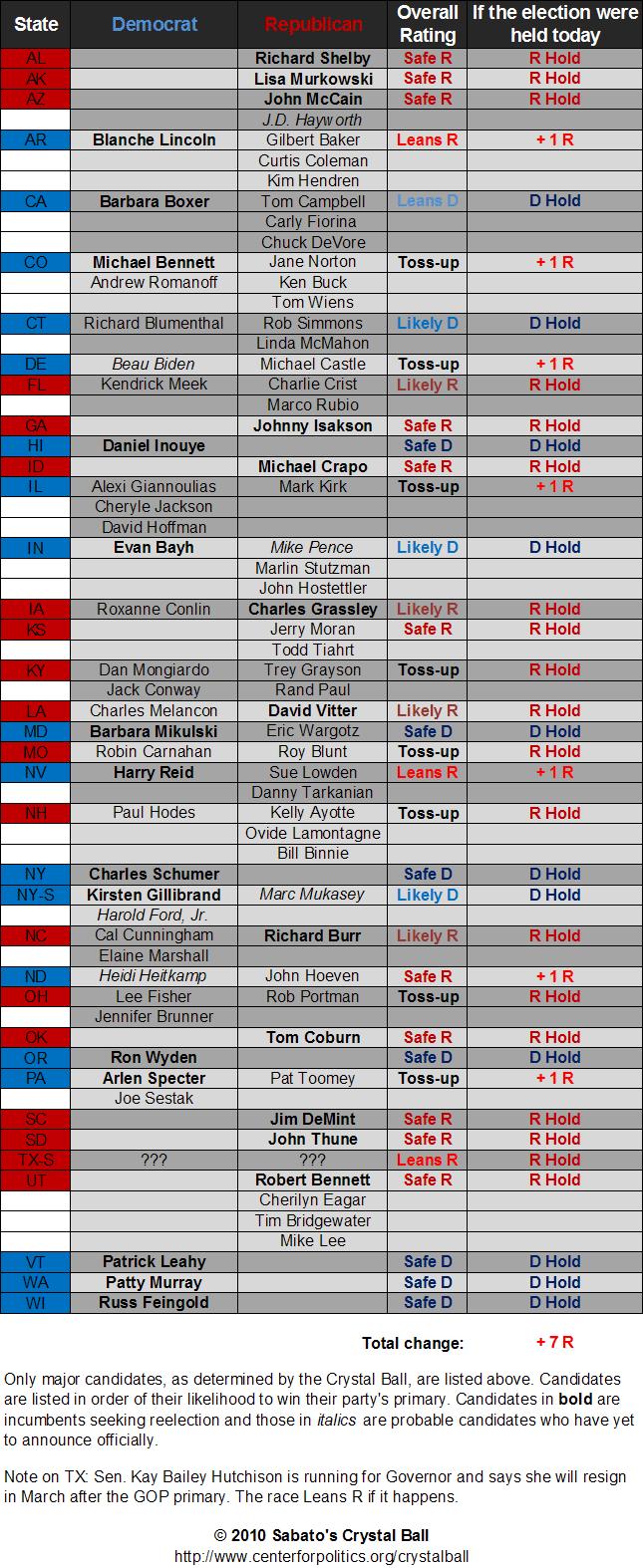Senate 2010: More Shocks on the Way
A Commentary By Larry J. Sabato
With Tuesday night’s upset by Republican Scott Brown in Massachusetts, the GOP gained more than just a 41st vote to disrupt the Obama agenda. As attention turns to the midterm elections in November, the Republican Party has strong momentum. A few months ago, even GOP leaders said that taking over the Senate was a pipe dream, and it is still not probable. But as some independents sour on the Democratic Party, the possibility for a GOP majority can no longer be dismissed out of hand. More likely, next year’s Senate will still have a Democratic majority but be much more closely balanced between Democrats and Republicans.
In fact, it is likely that the Republicans will gain at least 3 to 5 Senate seats in November. Even more startling, in the aftermath of the Massachusetts special election, Republicans would do even better IF the general election were being held today. The Crystal Ball projects that the Democratic majority in the Senate would be reduced to just 52 seats if November’s contests were somehow moved to January.
Luckily for the Democrats, the election is not today. By November the economy may be in much better shape, and some of the current controversies may appear less significant. Contests that would tip to the GOP today could easily wobble back to the Democrats (such as Missouri and Pennsylvania). That is why we still classify them as toss-ups overall.
At the same time, given Tuesday’s Bay State results, the Republican Party will search for, and possibly find, credible challengers for some Democratic senators believed to be safe until now. Imagining themselves as Scott Brown (on the victory stage, not in a Cosmo photo spread), a few “A” list Republicans might take a second look at the Senate and decide to jump in.
Among the senators who could be endangered by a new wave of Republican entries are Evan Bayh (Indiana), Kirsten Gillibrand (New York), Patty Murray (Washington), and Russ Feingold (Wisconsin).
An early example is Indiana, where Republican Congressman Mike Pence is reportedly weighing a challenge to Evan Bayh. The Hoosier State gave Obama its electoral votes in 2008 by a razor-thin margin. If Democrats could lose a Senate seat in Massachusetts, which Obama carried with 62 percent, it is theoretically possible that Indiana could be in play come November. The same is true for the other states. In politics you cannot beat somebody with nobody, but as Scott Brown proved, a nobody can become a somebody rather quickly in the right environment.
Post-Brown, the magic number for Republicans is 10 if the GOP is to take control of the Senate. (Vice President Joe Biden would cast the tie-breaking vote in favor of Democratic control should there be a 50-50 split.)
One wonders whether a 9-seat gain would be sufficient for the GOP, however. We all recall the May 2001 party switch of Vermont Senator Jim Jeffords from R to I-D. Might the Republicans lure Joe Lieberman of Connecticut, who sits in the Democratic caucus but is officially an independent? Lieberman is already persona non grata to liberal Democrats as well as a solid vote for the GOP on national security issues—and was nearly named the Republican vice presidential nominee by John McCain in 2008.
A lot can happen in a short time, as Tuesday showed anew. Democrats have plenty of chances to ward off this “Nightmare on November Street” if the economy and Obama’s approval ratings rebound over the next nine and a half months. For the moment, though, the Democrats’ nightmare is the Republican dream scenario, as our Senate rankings suggest.
Larry J. Sabato is the director of the Center for Politics at the University of Virginia.
See Other Commentary by Larry Sabato
See Other Political Commentary
Rasmussen Reports is a media company specializing in the collection, publication and distribution of public opinion information.
We conduct public opinion polls on a variety of topics to inform our audience on events in the news and other topics of interest. To ensure editorial control and independence, we pay for the polls ourselves and generate revenue through the sale of subscriptions, sponsorships, and advertising. Nightly polling on politics, business and lifestyle topics provides the content to update the Rasmussen Reports web site many times each day. If it's in the news, it's in our polls. Additionally, the data drives a daily update newsletter and various media outlets across the country.
Some information, including the Rasmussen Reports daily Presidential Tracking Poll and commentaries are available for free to the general public. Subscriptions are available for $4.95 a month or 34.95 a year that provide subscribers with exclusive access to more than 20 stories per week on upcoming elections, consumer confidence, and issues that affect us all. For those who are really into the numbers, Platinum Members can review demographic crosstabs and a full history of our data.
To learn more about our methodology, click here.

